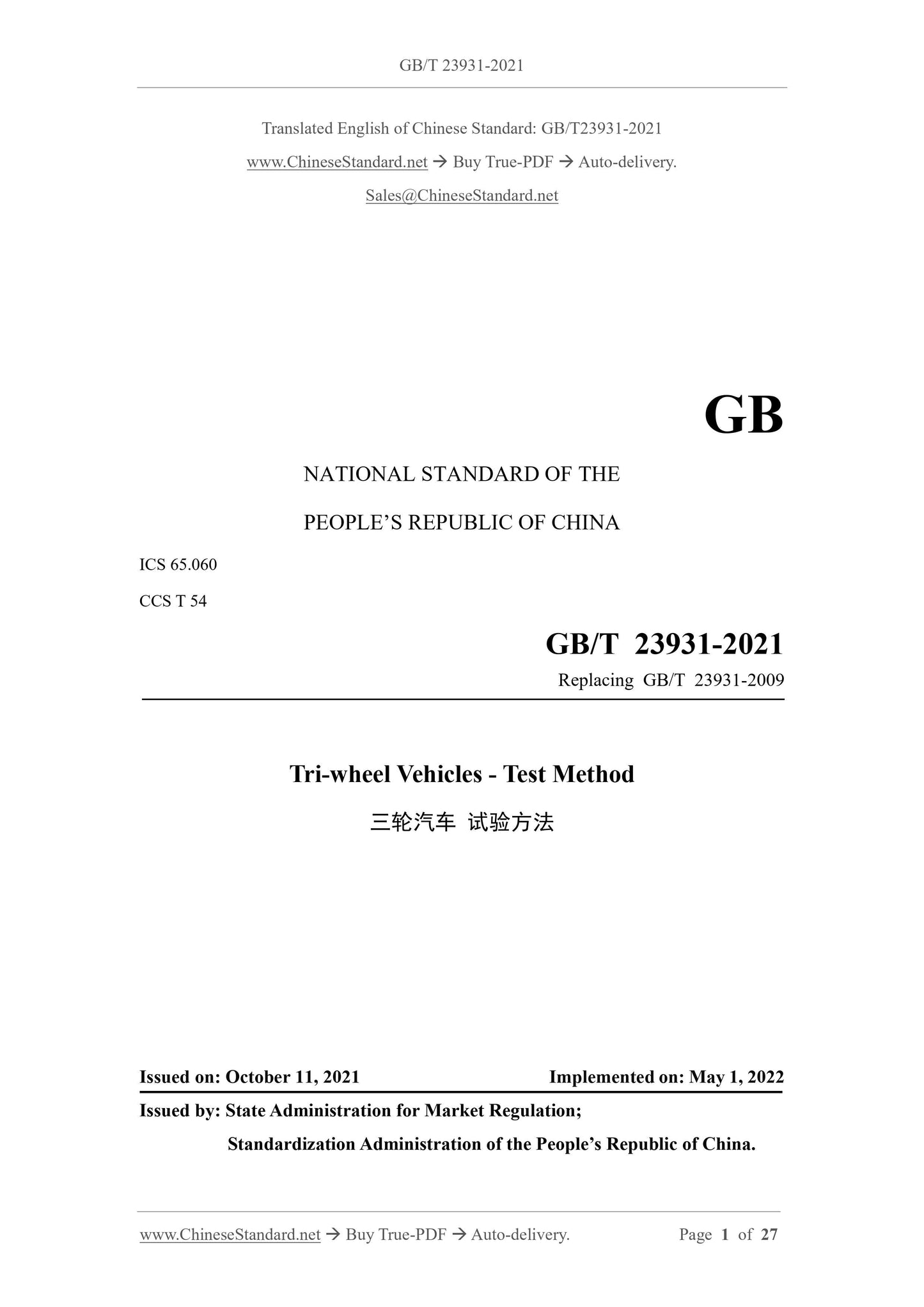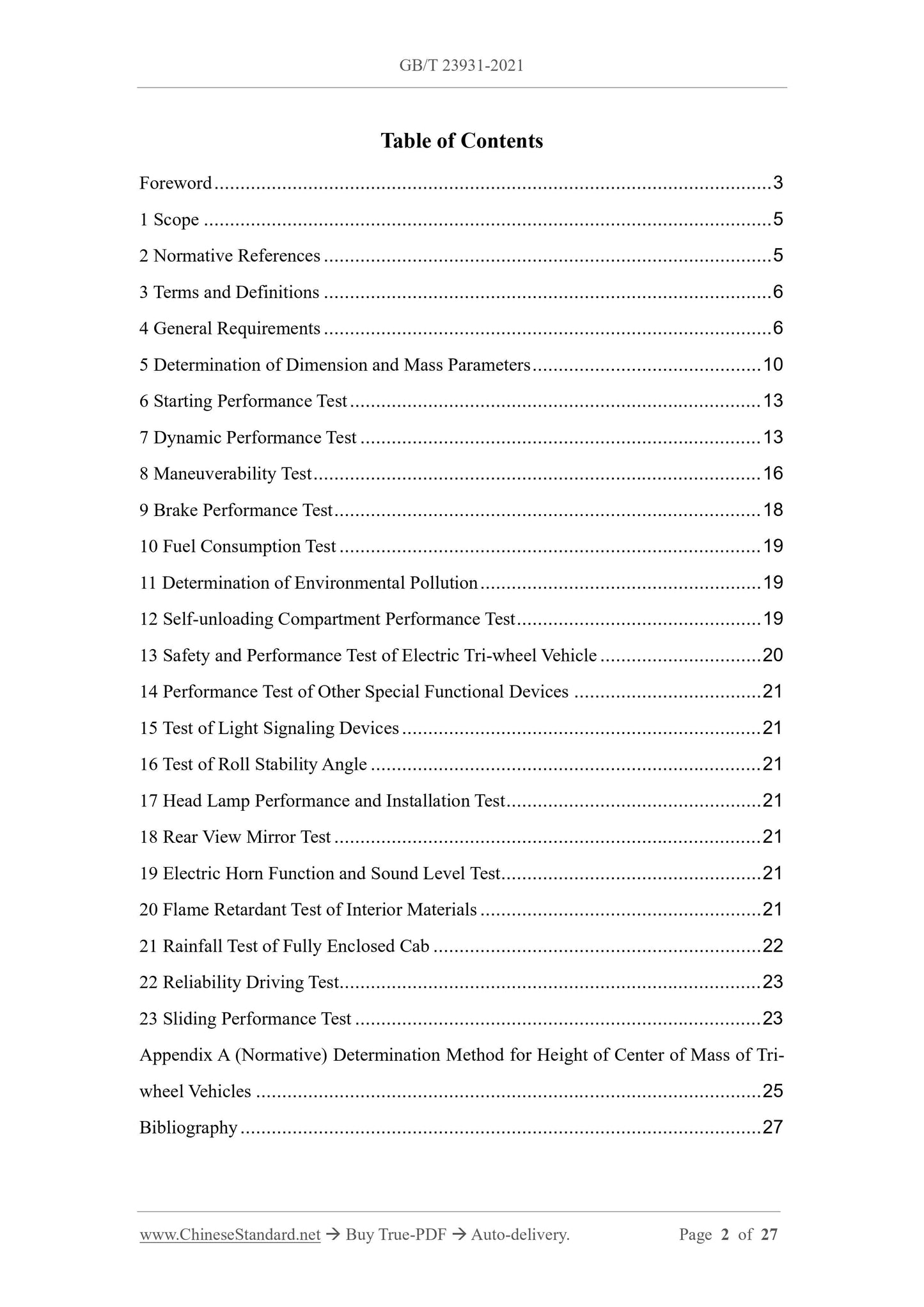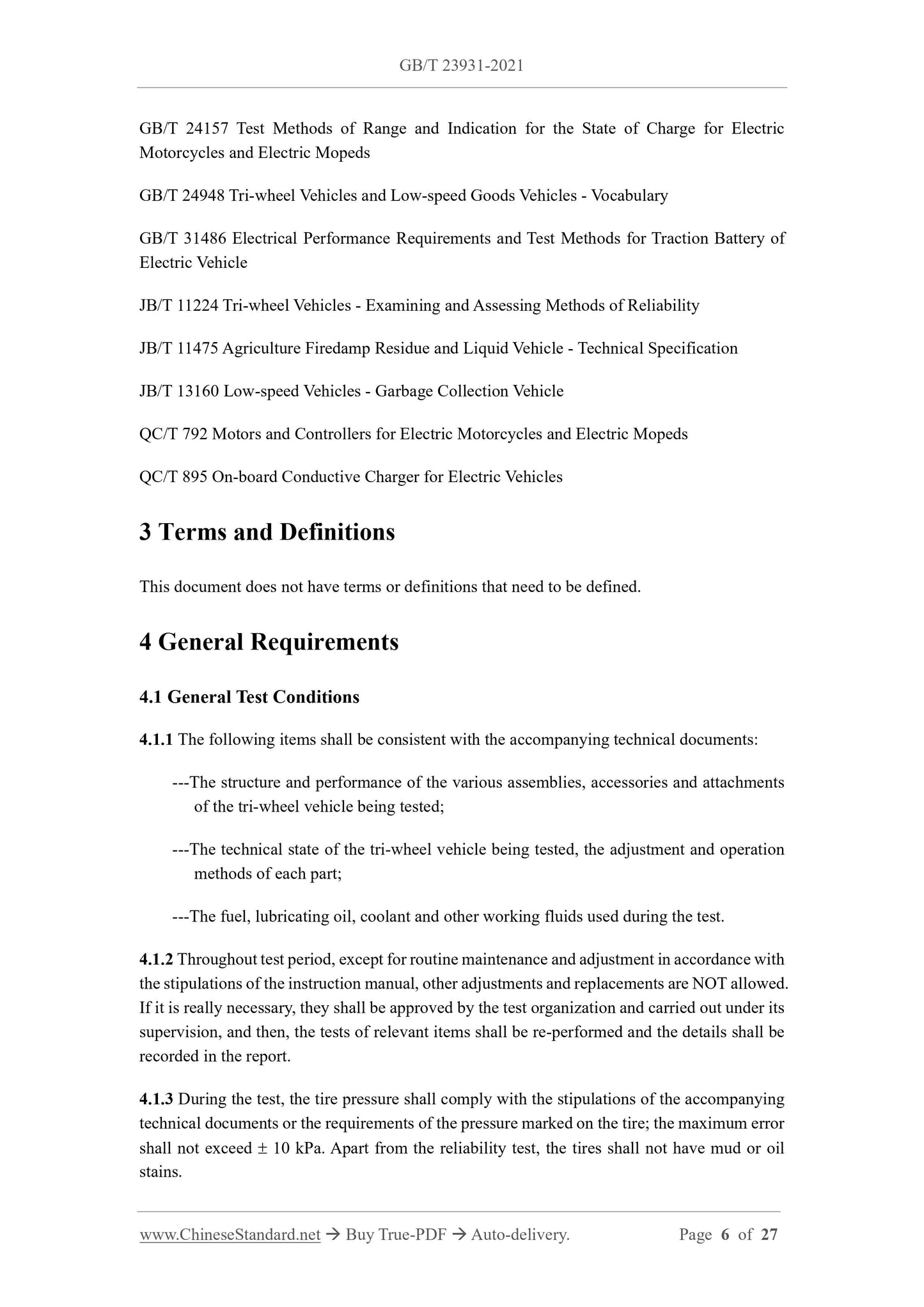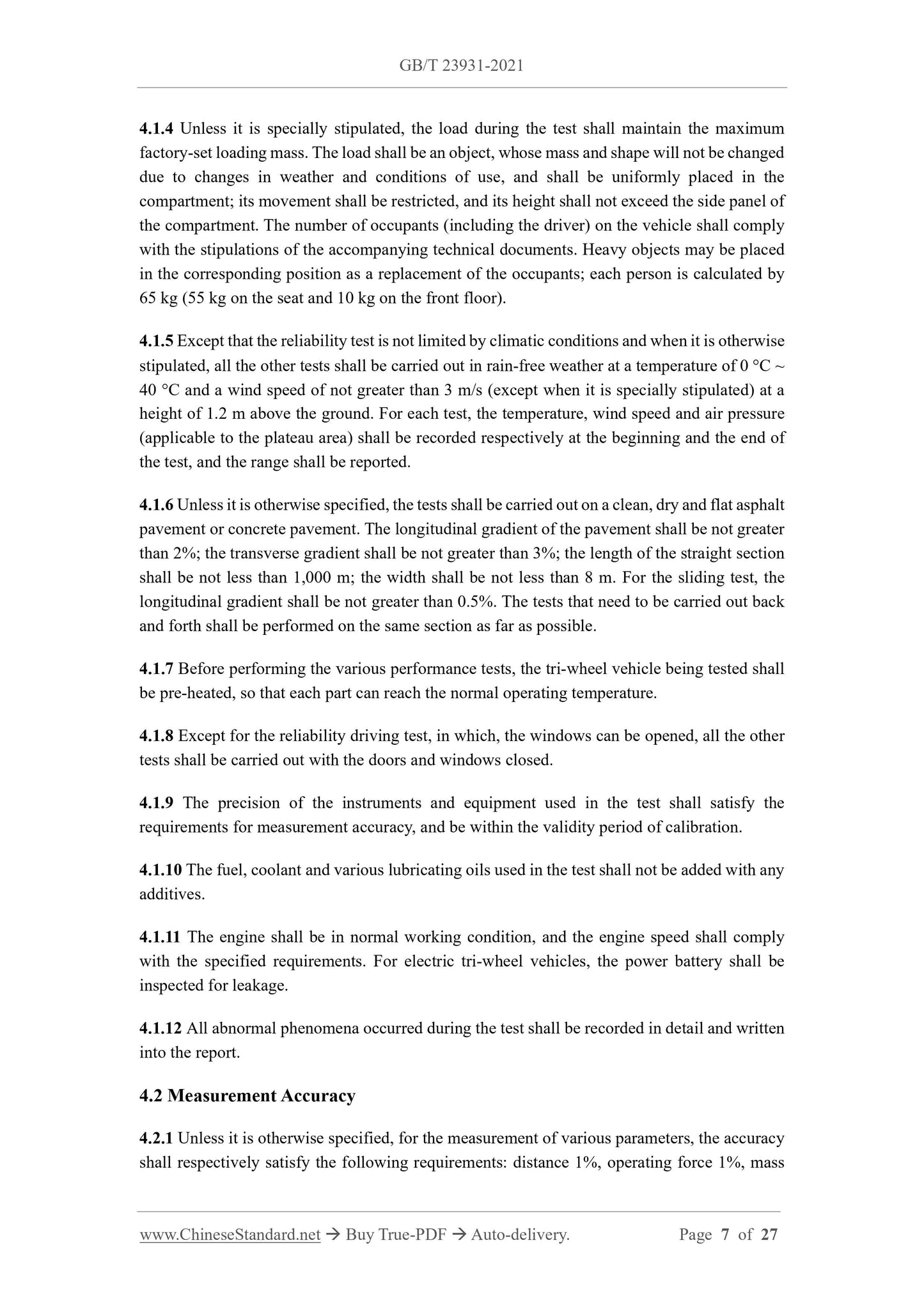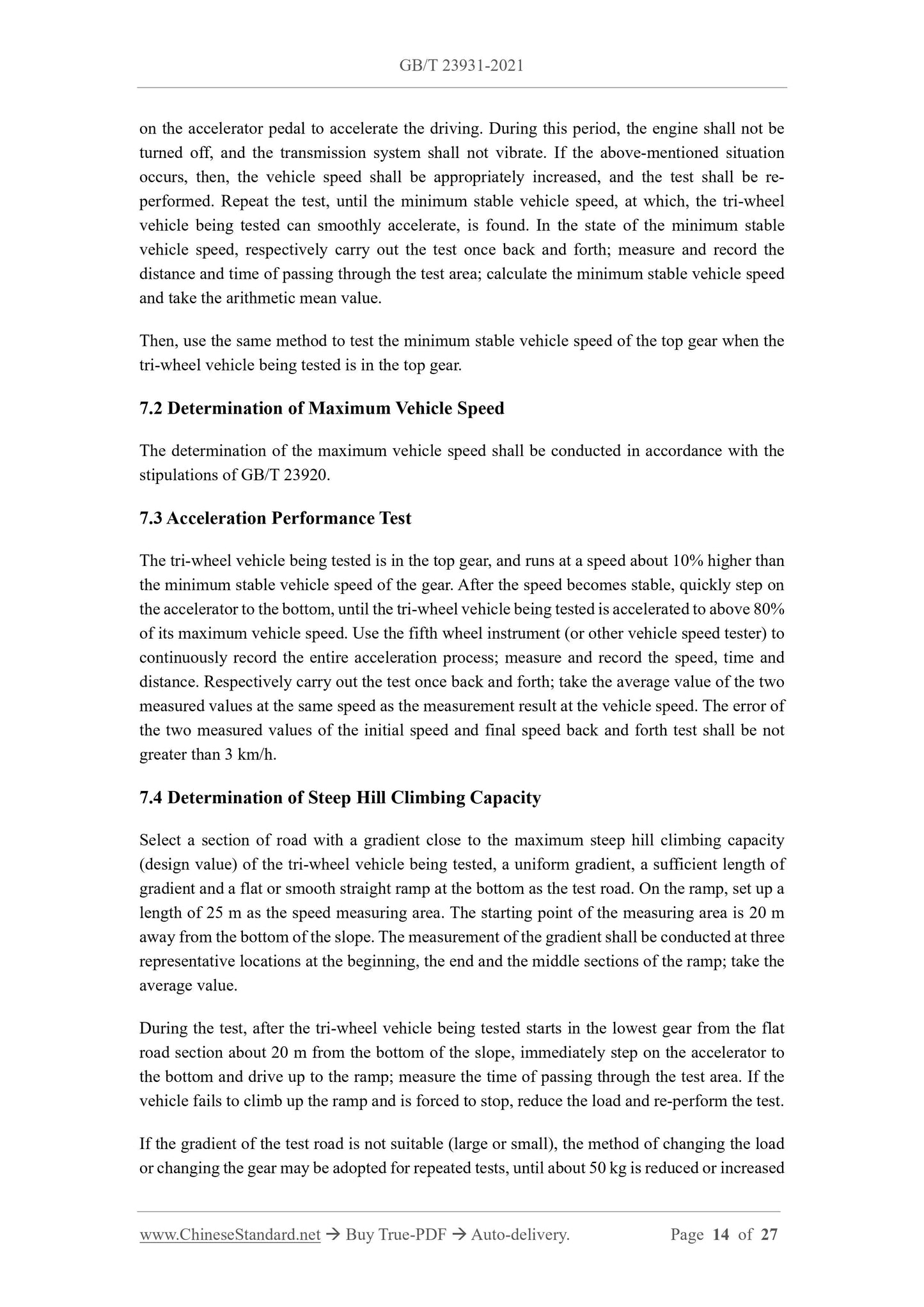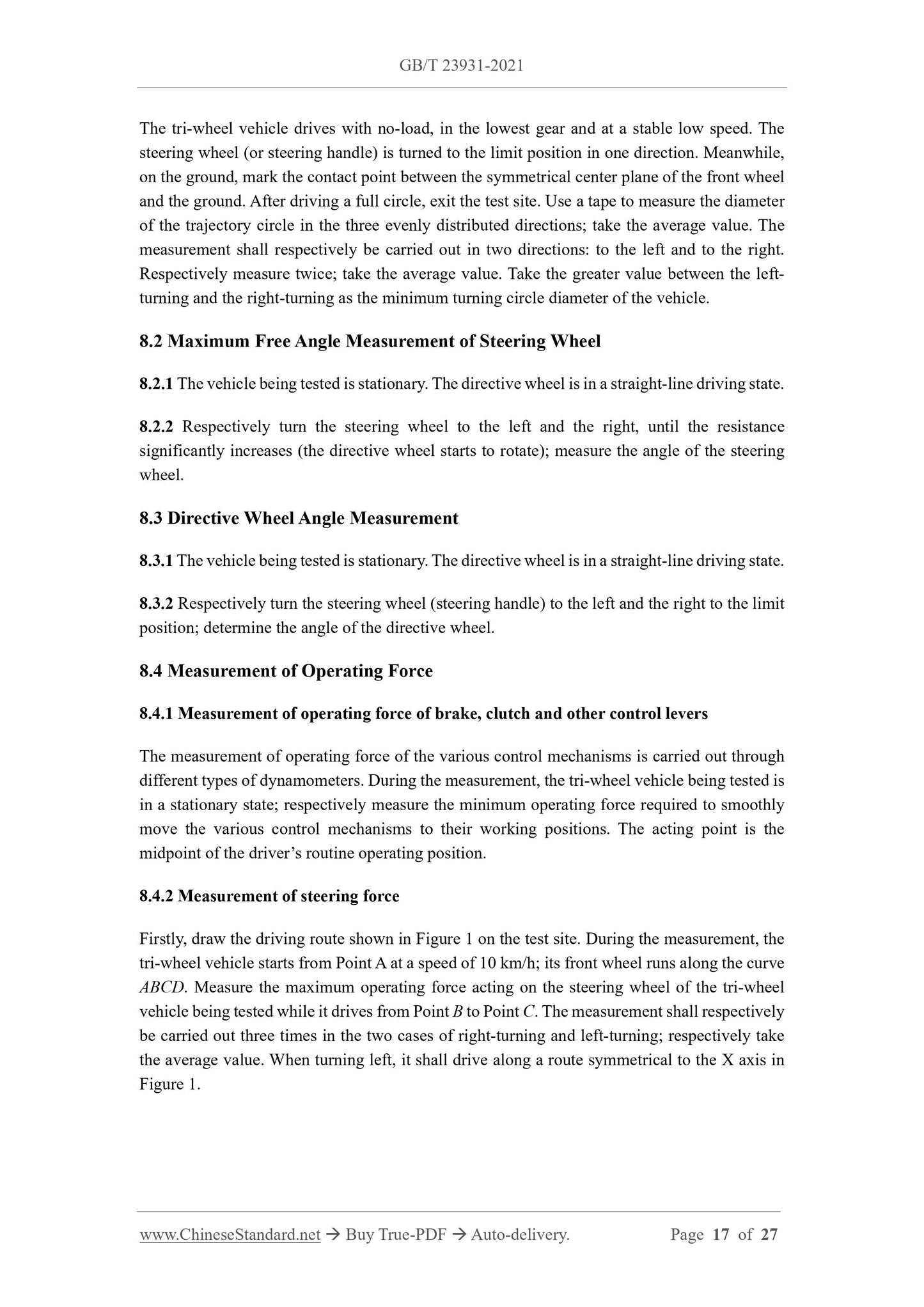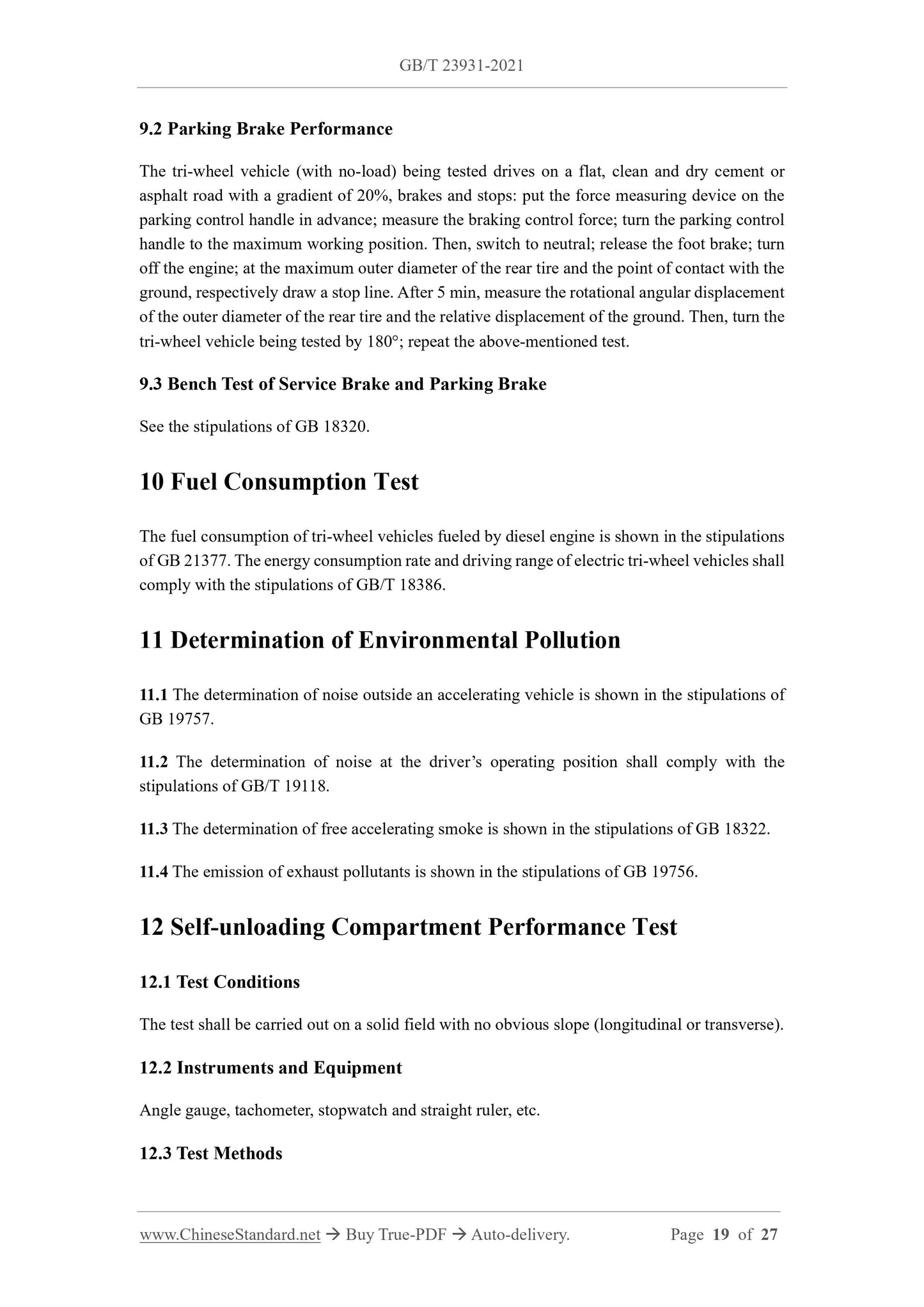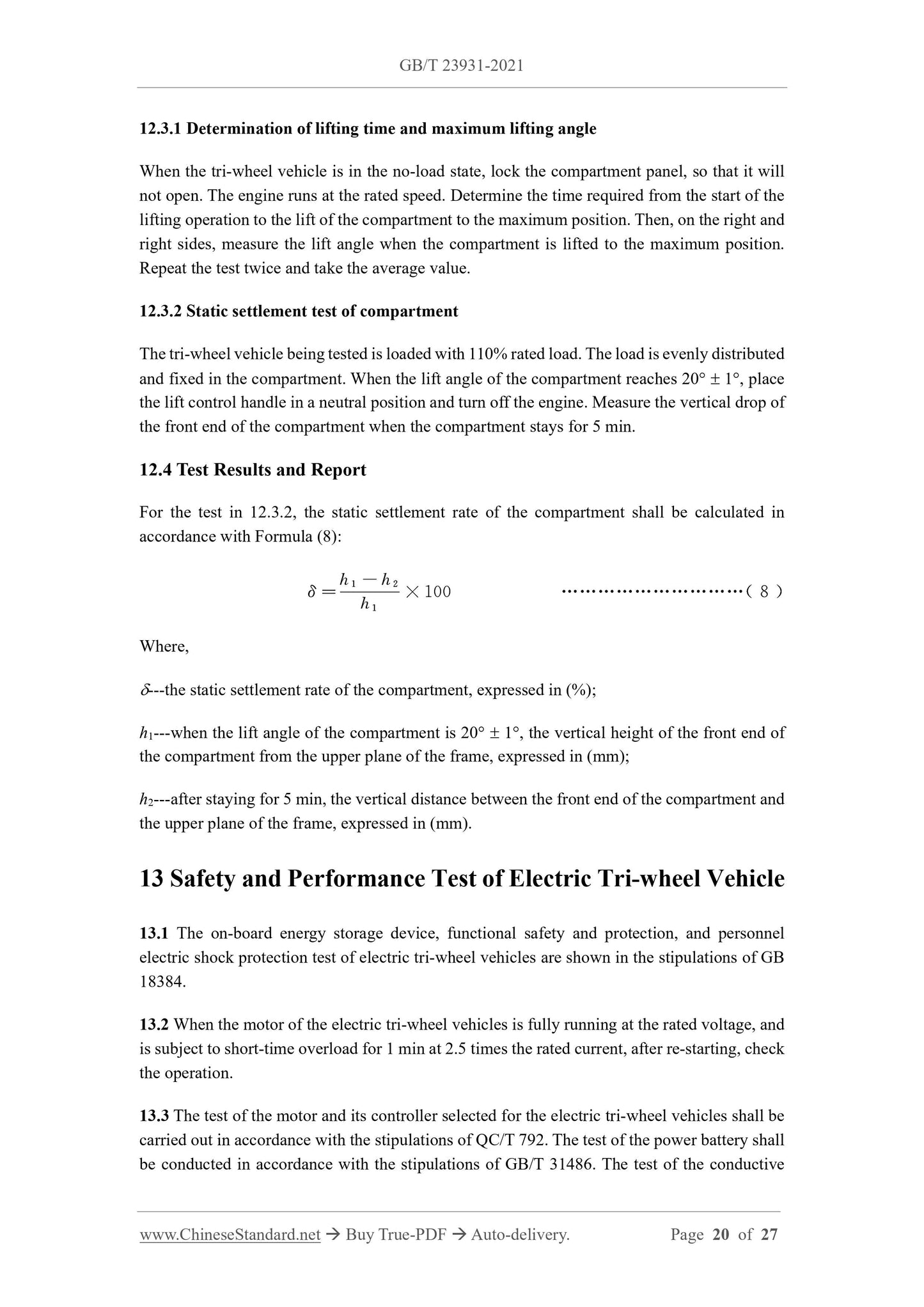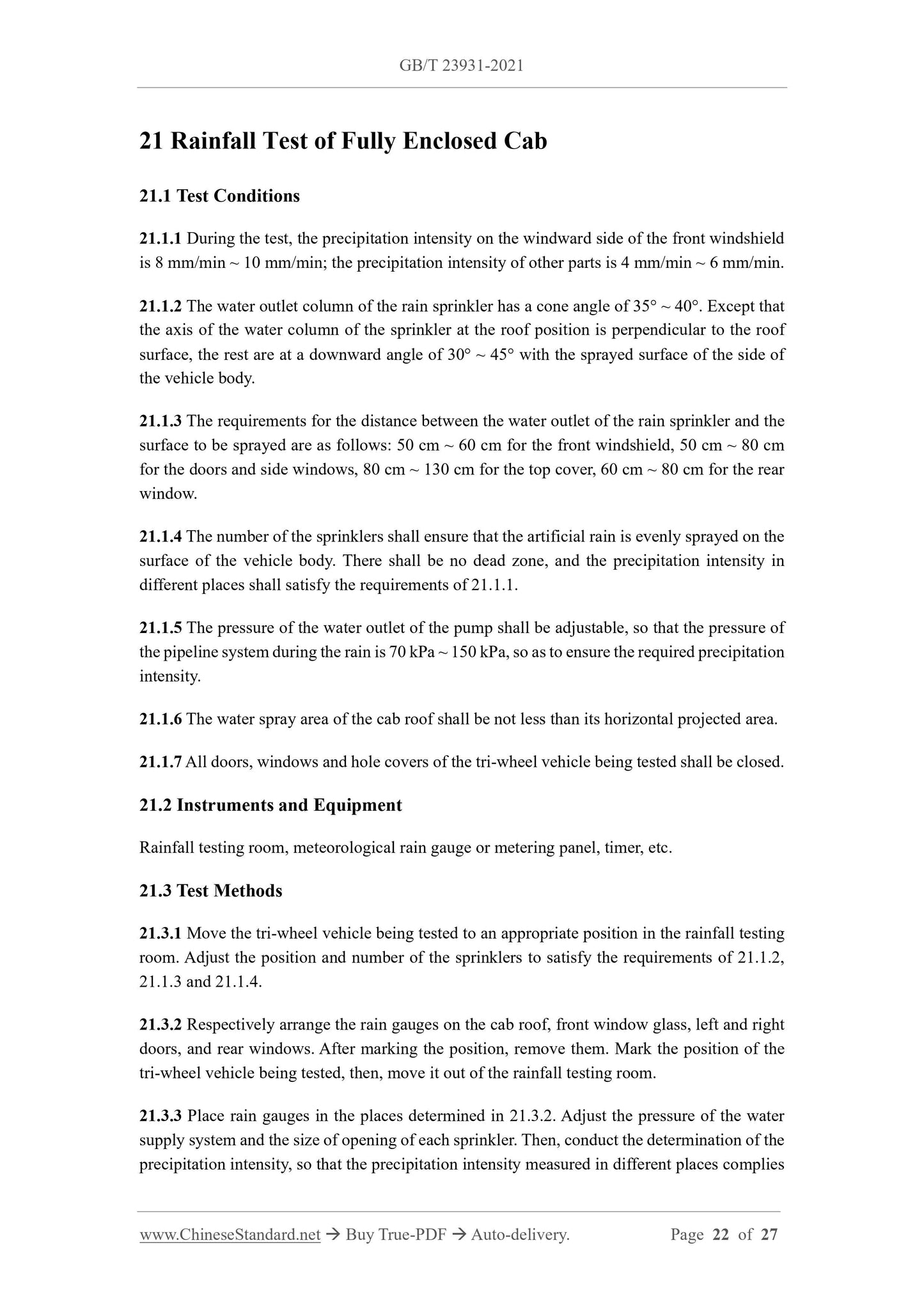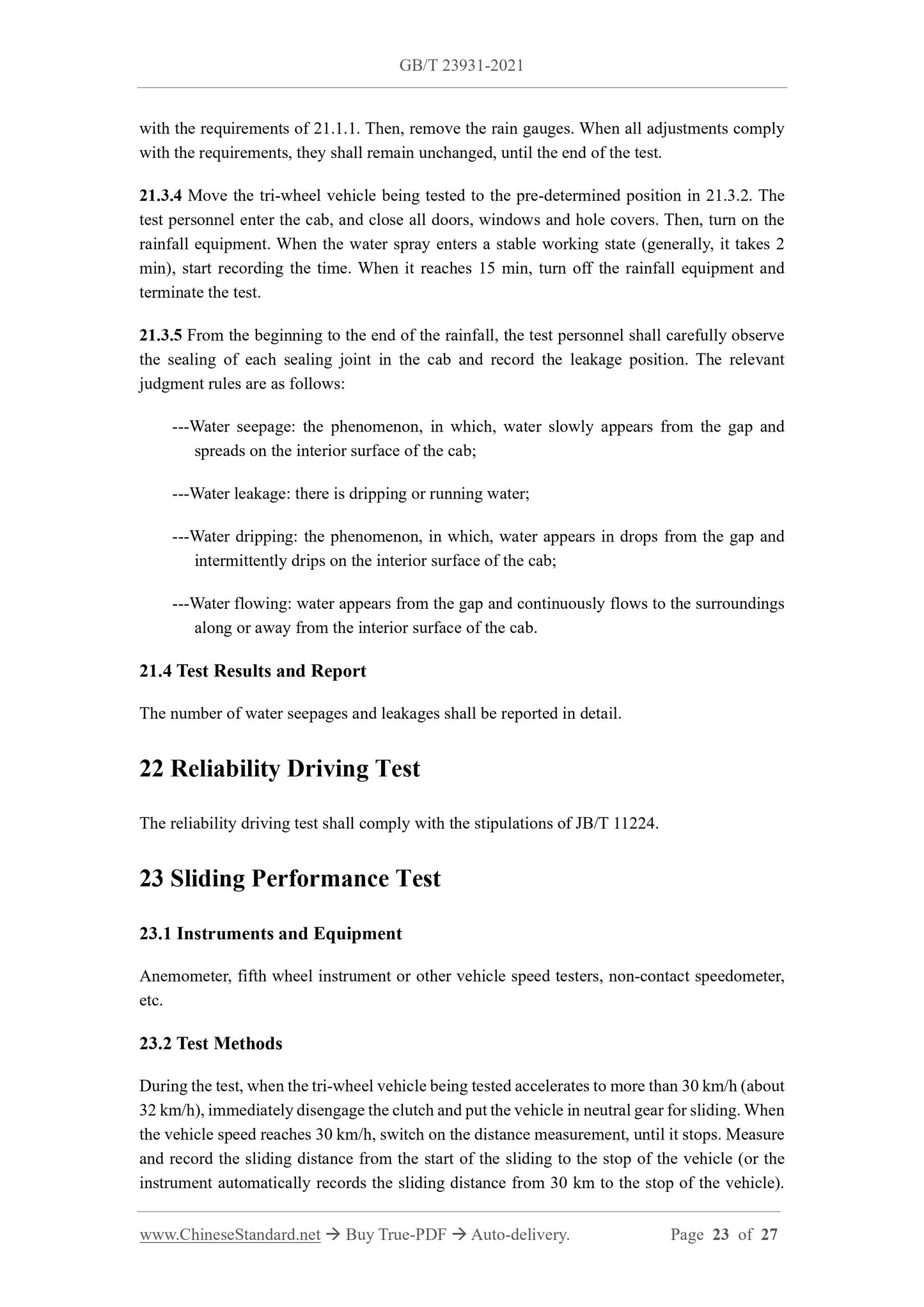1
/
de
10
PayPal, credit cards. Download editable-PDF & invoice In 1 second!
GB/T 23931-2021 English PDF (GBT23931-2021)
GB/T 23931-2021 English PDF (GBT23931-2021)
Prix habituel
$290.00 USD
Prix habituel
Prix promotionnel
$290.00 USD
Prix unitaire
/
par
Frais d'expédition calculés à l'étape de paiement.
Impossible de charger la disponibilité du service de retrait
Delivery: 3 seconds. Download true-PDF + Invoice.
Get QUOTATION in 1-minute: Click GB/T 23931-2021
Historical versions: GB/T 23931-2021
Preview True-PDF (Reload/Scroll if blank)
GB/T 23931-2021: Tri-wheel Vehicles - Test Method
GB/T 23931-2021
GB
NATIONAL STANDARD OF THE
PEOPLE’S REPUBLIC OF CHINA
ICS 65.060
CCS T 54
Replacing GB/T 23931-2009
Tri-wheel Vehicles - Test Method
ISSUED ON: OCTOBER 11, 2021
IMPLEMENTED ON: MAY 1, 2022
Issued by: State Administration for Market Regulation;
Standardization Administration of the People’s Republic of China.
Table of Contents
Foreword ... 3
1 Scope ... 5
2 Normative References ... 5
3 Terms and Definitions ... 6
4 General Requirements ... 6
5 Determination of Dimension and Mass Parameters ... 10
6 Starting Performance Test ... 13
7 Dynamic Performance Test ... 13
8 Maneuverability Test ... 16
9 Brake Performance Test ... 18
10 Fuel Consumption Test ... 19
11 Determination of Environmental Pollution ... 19
12 Self-unloading Compartment Performance Test ... 19
13 Safety and Performance Test of Electric Tri-wheel Vehicle ... 20
14 Performance Test of Other Special Functional Devices ... 21
15 Test of Light Signaling Devices ... 21
16 Test of Roll Stability Angle ... 21
17 Head Lamp Performance and Installation Test ... 21
18 Rear View Mirror Test ... 21
19 Electric Horn Function and Sound Level Test ... 21
20 Flame Retardant Test of Interior Materials ... 21
21 Rainfall Test of Fully Enclosed Cab ... 22
22 Reliability Driving Test... 23
23 Sliding Performance Test ... 23
Appendix A (Normative) Determination Method for Height of Center of Mass of Tri-
wheel Vehicles ... 25
Bibliography ... 27
GB/T 24157 Test Methods of Range and Indication for the State of Charge for Electric
Motorcycles and Electric Mopeds
GB/T 24948 Tri-wheel Vehicles and Low-speed Goods Vehicles - Vocabulary
GB/T 31486 Electrical Performance Requirements and Test Methods for Traction Battery of
Electric Vehicle
JB/T 11224 Tri-wheel Vehicles - Examining and Assessing Methods of Reliability
JB/T 11475 Agriculture Firedamp Residue and Liquid Vehicle - Technical Specification
JB/T 13160 Low-speed Vehicles - Garbage Collection Vehicle
QC/T 792 Motors and Controllers for Electric Motorcycles and Electric Mopeds
QC/T 895 On-board Conductive Charger for Electric Vehicles
3 Terms and Definitions
This document does not have terms or definitions that need to be defined.
4 General Requirements
4.1 General Test Conditions
4.1.1 The following items shall be consistent with the accompanying technical documents:
---The structure and performance of the various assemblies, accessories and attachments
of the tri-wheel vehicle being tested;
---The technical state of the tri-wheel vehicle being tested, the adjustment and operation
methods of each part;
---The fuel, lubricating oil, coolant and other working fluids used during the test.
4.1.2 Throughout test period, except for routine maintenance and adjustment in accordance with
the stipulations of the instruction manual, other adjustments and replacements are NOT allowed.
If it is really necessary, they shall be approved by the test organization and carried out under its
supervision, and then, the tests of relevant items shall be re-performed and the details shall be
recorded in the report.
4.1.3 During the test, the tire pressure shall comply with the stipulations of the accompanying
technical documents or the requirements of the pressure marked on the tire; the maximum error
shall not exceed 10 kPa. Apart from the reliability test, the tires shall not have mud or oil
stains.
4.1.4 Unless it is specially stipulated, the load during the test shall maintain the maximum
factory-set loading mass. The load shall be an object, whose mass and shape will not be changed
due to changes in weather and conditions of use, and shall be uniformly placed in the
compartment; its movement shall be restricted, and its height shall not exceed the side panel of
the compartment. The number of occupants (including the driver) on the vehicle shall comply
with the stipulations of the accompanying technical documents. Heavy objects may be placed
in the corresponding position as a replacement of the occupants; each person is calculated by
65 kg (55 kg on the seat and 10 kg on the front floor).
4.1.5 Except that the reliability test is not limited by climatic conditions and when it is otherwise
stipulated, all the other tests shall be carried out in rain-free weather at a temperature of 0 C ~
40 C and a wind speed of not greater than 3 m/s (except when it is specially stipulated) at a
height of 1.2 m above the ground. For each test, the temperature, wind speed and air pressure
(applicable to the plateau area) shall be recorded respectively at the beginning and the end of
the test, and the range shall be reported.
4.1.6 Unless it is otherwise specified, the tests shall be carried out on a clean, dry and flat asphalt
pavement or concrete pavement. The longitudinal gradient of the pavement shall be not greater
than 2%; the transverse gradient shall be not greater than 3%; the length of the straight section
shall be not less than 1,000 m; the width shall be not less than 8 m. For the sliding test, the
longitudinal gradient shall be not greater than 0.5%. The tests that need to be carried out back
and forth shall be performed on the same section as far as possible.
4.1.7 Before performing the various performance tests, the tri-wheel vehicle being tested shall
be pre-heated, so that each part can reach the normal operating temperature.
4.1.8 Except for the reliability driving test, in which, the windows can be opened, all the other
tests shall be carried out with the doors and windows closed.
4.1.9 The precision of the instruments and equipment used in the test shall satisfy the
requirements for measurement accuracy, and be within the validity period of calibration.
4.1.10 The fuel, coolant and various lubricating oils used in the test shall not be added with any
additives.
4.1.11 The engine shall be in normal working condition, and the engine speed shall comply
with the specified requirements. For electric tri-wheel vehicles, the power battery shall be
inspected for leakage.
4.1.12 All abnormal phenomena occurred during the test shall be recorded in detail and written
into the report.
4.2 Measurement Accuracy
4.2.1 Unless it is otherwise specified, for the measurement of various parameters, the accuracy
shall respectively satisfy the following requirements: distance 1%, operating force 1%, mass
on the accelerator pedal to accelerate the driving. During this period, the engine shall not be
turned off, and the transmission system shall not vibrate. If the above-mentioned situation
occurs, then, the vehicle speed shall be appropriately increased, and the test shall be re-
performed. Repeat the test, until the minimum stable vehicle speed, at which, the tri-wheel
vehicle being tested can smoothly accelerate, is found. In the state of the minimum stable
vehicle speed, respectively carry out the test once back and forth; measure and record the
distance and time of passing through the test area; calculate the minimum stable vehicle speed
and take the arithmetic mean value.
Then, use the same method to test the minimum stable vehicle speed of the top gear when the
tri-wheel vehicle being tested is in the top gear.
7.2 Determination of Maximum Vehicle Speed
The determination of the maximum vehicle speed shall be conducted in accordance with the
stipulations of GB/T 23920.
7.3 Acceleration Performance Test
The tri-wheel vehicle being tested is in the top gear, and...
Get QUOTATION in 1-minute: Click GB/T 23931-2021
Historical versions: GB/T 23931-2021
Preview True-PDF (Reload/Scroll if blank)
GB/T 23931-2021: Tri-wheel Vehicles - Test Method
GB/T 23931-2021
GB
NATIONAL STANDARD OF THE
PEOPLE’S REPUBLIC OF CHINA
ICS 65.060
CCS T 54
Replacing GB/T 23931-2009
Tri-wheel Vehicles - Test Method
ISSUED ON: OCTOBER 11, 2021
IMPLEMENTED ON: MAY 1, 2022
Issued by: State Administration for Market Regulation;
Standardization Administration of the People’s Republic of China.
Table of Contents
Foreword ... 3
1 Scope ... 5
2 Normative References ... 5
3 Terms and Definitions ... 6
4 General Requirements ... 6
5 Determination of Dimension and Mass Parameters ... 10
6 Starting Performance Test ... 13
7 Dynamic Performance Test ... 13
8 Maneuverability Test ... 16
9 Brake Performance Test ... 18
10 Fuel Consumption Test ... 19
11 Determination of Environmental Pollution ... 19
12 Self-unloading Compartment Performance Test ... 19
13 Safety and Performance Test of Electric Tri-wheel Vehicle ... 20
14 Performance Test of Other Special Functional Devices ... 21
15 Test of Light Signaling Devices ... 21
16 Test of Roll Stability Angle ... 21
17 Head Lamp Performance and Installation Test ... 21
18 Rear View Mirror Test ... 21
19 Electric Horn Function and Sound Level Test ... 21
20 Flame Retardant Test of Interior Materials ... 21
21 Rainfall Test of Fully Enclosed Cab ... 22
22 Reliability Driving Test... 23
23 Sliding Performance Test ... 23
Appendix A (Normative) Determination Method for Height of Center of Mass of Tri-
wheel Vehicles ... 25
Bibliography ... 27
GB/T 24157 Test Methods of Range and Indication for the State of Charge for Electric
Motorcycles and Electric Mopeds
GB/T 24948 Tri-wheel Vehicles and Low-speed Goods Vehicles - Vocabulary
GB/T 31486 Electrical Performance Requirements and Test Methods for Traction Battery of
Electric Vehicle
JB/T 11224 Tri-wheel Vehicles - Examining and Assessing Methods of Reliability
JB/T 11475 Agriculture Firedamp Residue and Liquid Vehicle - Technical Specification
JB/T 13160 Low-speed Vehicles - Garbage Collection Vehicle
QC/T 792 Motors and Controllers for Electric Motorcycles and Electric Mopeds
QC/T 895 On-board Conductive Charger for Electric Vehicles
3 Terms and Definitions
This document does not have terms or definitions that need to be defined.
4 General Requirements
4.1 General Test Conditions
4.1.1 The following items shall be consistent with the accompanying technical documents:
---The structure and performance of the various assemblies, accessories and attachments
of the tri-wheel vehicle being tested;
---The technical state of the tri-wheel vehicle being tested, the adjustment and operation
methods of each part;
---The fuel, lubricating oil, coolant and other working fluids used during the test.
4.1.2 Throughout test period, except for routine maintenance and adjustment in accordance with
the stipulations of the instruction manual, other adjustments and replacements are NOT allowed.
If it is really necessary, they shall be approved by the test organization and carried out under its
supervision, and then, the tests of relevant items shall be re-performed and the details shall be
recorded in the report.
4.1.3 During the test, the tire pressure shall comply with the stipulations of the accompanying
technical documents or the requirements of the pressure marked on the tire; the maximum error
shall not exceed 10 kPa. Apart from the reliability test, the tires shall not have mud or oil
stains.
4.1.4 Unless it is specially stipulated, the load during the test shall maintain the maximum
factory-set loading mass. The load shall be an object, whose mass and shape will not be changed
due to changes in weather and conditions of use, and shall be uniformly placed in the
compartment; its movement shall be restricted, and its height shall not exceed the side panel of
the compartment. The number of occupants (including the driver) on the vehicle shall comply
with the stipulations of the accompanying technical documents. Heavy objects may be placed
in the corresponding position as a replacement of the occupants; each person is calculated by
65 kg (55 kg on the seat and 10 kg on the front floor).
4.1.5 Except that the reliability test is not limited by climatic conditions and when it is otherwise
stipulated, all the other tests shall be carried out in rain-free weather at a temperature of 0 C ~
40 C and a wind speed of not greater than 3 m/s (except when it is specially stipulated) at a
height of 1.2 m above the ground. For each test, the temperature, wind speed and air pressure
(applicable to the plateau area) shall be recorded respectively at the beginning and the end of
the test, and the range shall be reported.
4.1.6 Unless it is otherwise specified, the tests shall be carried out on a clean, dry and flat asphalt
pavement or concrete pavement. The longitudinal gradient of the pavement shall be not greater
than 2%; the transverse gradient shall be not greater than 3%; the length of the straight section
shall be not less than 1,000 m; the width shall be not less than 8 m. For the sliding test, the
longitudinal gradient shall be not greater than 0.5%. The tests that need to be carried out back
and forth shall be performed on the same section as far as possible.
4.1.7 Before performing the various performance tests, the tri-wheel vehicle being tested shall
be pre-heated, so that each part can reach the normal operating temperature.
4.1.8 Except for the reliability driving test, in which, the windows can be opened, all the other
tests shall be carried out with the doors and windows closed.
4.1.9 The precision of the instruments and equipment used in the test shall satisfy the
requirements for measurement accuracy, and be within the validity period of calibration.
4.1.10 The fuel, coolant and various lubricating oils used in the test shall not be added with any
additives.
4.1.11 The engine shall be in normal working condition, and the engine speed shall comply
with the specified requirements. For electric tri-wheel vehicles, the power battery shall be
inspected for leakage.
4.1.12 All abnormal phenomena occurred during the test shall be recorded in detail and written
into the report.
4.2 Measurement Accuracy
4.2.1 Unless it is otherwise specified, for the measurement of various parameters, the accuracy
shall respectively satisfy the following requirements: distance 1%, operating force 1%, mass
on the accelerator pedal to accelerate the driving. During this period, the engine shall not be
turned off, and the transmission system shall not vibrate. If the above-mentioned situation
occurs, then, the vehicle speed shall be appropriately increased, and the test shall be re-
performed. Repeat the test, until the minimum stable vehicle speed, at which, the tri-wheel
vehicle being tested can smoothly accelerate, is found. In the state of the minimum stable
vehicle speed, respectively carry out the test once back and forth; measure and record the
distance and time of passing through the test area; calculate the minimum stable vehicle speed
and take the arithmetic mean value.
Then, use the same method to test the minimum stable vehicle speed of the top gear when the
tri-wheel vehicle being tested is in the top gear.
7.2 Determination of Maximum Vehicle Speed
The determination of the maximum vehicle speed shall be conducted in accordance with the
stipulations of GB/T 23920.
7.3 Acceleration Performance Test
The tri-wheel vehicle being tested is in the top gear, and...
Share
